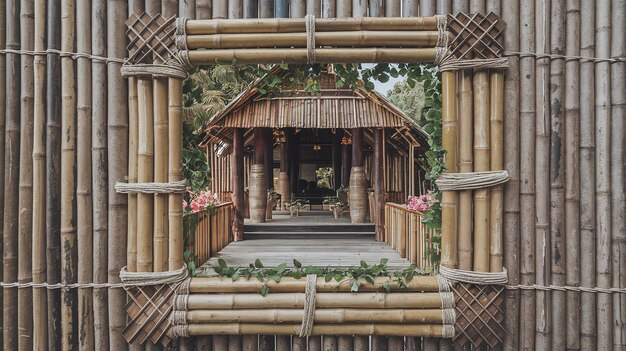Need fulfillment being well established as a fundamental human need it has never been more possible, at least for low and middle income earners in the United States, to have a house. We then require affordable houses and bamboo is well suited as a structural or building material type. Bamboo is among the tallest and youngest plant types; it is one of those referred to as the grass C. Original Bamboos are among the fastest growing plants in Asia, South America, Africa and all over the world. It has had uses in food and medicine and construction among others for instance for thousands of years. This material has proved popular for use in construction because it is strong, flexible and quite sturdy.
Hence in this blog Walls and Dreams will explicate all rudimentary details on bamboo for construction, reasons for utilization of bamboo in construction, properties of bamboo used in construction, advantages as well as disbenefits of bamboo, utilization of bamboo and limitation of bamboo in construction.
Why is Bamboo Used as a Building Material?
Bamboo is an affordable material that is obtained from the fastest growing of all the renewable natural building materials.
- Apart from being relatively cheaper, it is easy to handle or manage.
- It may also refer to the use of bamboo as the leading building material for housing to the exclusion of steel concrete and masonry.
- I need to be quite elastic and actually one can twist it into the required form and make joints as per the design.
- Because of the high elasticity, bamboo is the most suitable construction material when it can be used in constructing buildings for places that experience frequent quakes.
Properties of Bamboo as a Construction Material
The following are the properties of bamboo that make it a suitable construction material:
Durability
Primarily bamboo has good strength or durability in harsh climates, it does not decay, wear or get affected by water. In other words, even with the least amount of effort and care, it will survive the weather and last for many years. Regrettably it is not very durable making it less suitable for items such as fences or decking when used indoors or protected from the elements. This kind of of project is favorable for low cost construction material and maintenance given that it is naturally immune to the elements and waterchure
Strength
Bamboo is very strong and hard, it also has twice the tensile strength than the strength of steel. It therefore finds application construction of bridges and all other structures that require strength and stability. The following natural resources that can be tapped from bamboo: These can be used as beams and columns to put up structures such as homes among others.
Flexibility
Bamboo is a hard and flexible material which has made it to be used in construction work. Bamboo is a flexible material and does not snap easily; therefore it is useful in swaying with winds or in cases of earthquakes. Therefore, it’s also ideal for constructing rounded arches, curved roofs and ceilings and other designs.
Shrinkage
Complementary to this, bamboo shrinks and wanes twice the extent it would compared with wood. It thins with a wall thickness of 15%–17% and c/s of 10%–16%. Hence, considerable measures have to be taken to prevent loss of water.
Shearing Strength
Shearing resistance is specifically relevant for bamboo tube joints production. With increasing length of the shearing surface, the role of distance starts reducing.
Flexural Strength or Bending Strength
Unlike most trees, bamboo has good flexural strength. In fact if you so wish when bending the fresh bamboo, then the result that you get can be amazing.
Various Structural Shapes of Bamboo as a Building Material
Bamboos are grown with care to help them take on desired structures and forms:
Arch Shapes
It can further be formed to be arches by bending its growth to the desired shape. This would be less costly than the conventional timber to be used in forming a similar shape.
A Squared Cross-Section
Another way of doing so is to compress the growing stalk of bamboo in a square cross-section way.
Curved and Flat Shapes
Traditionally, pressure and heat processes make it possible to use bamboo in curved and flat parts of buildings.
Uses of Bamboo in Construction
The sustainable building material such as bamboo has the following uses. For these reasons, bamboo is a very useful material because; it is very strong for its weight, workable, and available. Nevertheless, due to its very poor natural hardness bamboo needs chemical treatment to make it hard. Flight, railings, partitions, walls, ceilings, roofs, truss and frame-work or construction, reed boards, flooring, doors and windows and carriers for hoardings, framework of buildings, basis of the buildings and many more.
Advantages of Bamboo in Building Construction
The following are the various advantages of bamboo as a construction material:
In general, bamboo is very versatile in its use in construction and structure based projects because of the specific physical characteristics. It is a very flexible material; therefore, you can fold it anyhow you wish. Bamboo is an innovative and replanted natural material.
Disadvantages of Bamboo in Building Construction
The two are a polymer and a low-density, high-strength and tensile strength material.
- Being light with dimensional stability, bamboo can be easily cut, handled, repaired and mobilized and does not require sturdy tools or equipment for maintenance.
- Bamboo could be employed especially in permanent structures and in cases of temporary construction.
- That is, bamboo can be used in conjunction with all kinds of other forms of construction materials.
- For using bamboo as a construction material, the design, guidelines and codes are inadequate.
- Should the preservation process not be done right; making it more vulnerable to attackers such as fungi.
- This is rather vulnerable to self-ignition.
Challenges of Using Bamboo in Construction
You may face the following challenges when using bamboo as a construction material:
Procurement
At times, the largest quality sustainable bamboo is difficult to come by and quality assurance is a major factor.
Expertise
Its utilization in construction work is not common and little understood by either engineers, architects and builders.
Transportation
Distance transportation of bamboo is costly and exposes the material to vices/ Final-points-of-call bamboo is often damaged.
Weather Condition
Vulnerability of the bamboo to decay and insect menace in humid conditions prevailing in India.
Conclusion
In conclusion, it can be suggested that bamboo offers a realistic answer to such emergent problems related to affordable housing. It is cheaper as well as more sustainable than traditional construction materials because of the rapid growth, density, and malleability. There are prominent benefits related to bamboo specifically, sustainability, and versatility that emphasizes the need for bamboo as a key element in effecting change in the construction industry despite some challenges that include preservation concerns and lack of knowledge. Therefore, when it comes to using bamboo in creating a more open, green and reasonable approach to the establishment of housing; it would offer the route to a much-maintained lifestyle.







